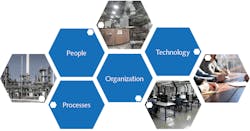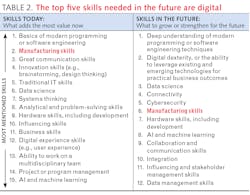Companies currently face challenges from multiple directions. What does demand look like for a company’s product? How does a company ensure that it has the right (and best) suppliers to meet that demand? What changes should a company expect to see in its workforce and what does it need to do to develop critical future skills? How does a company envision and deploy digital tools? COVID-19 has simply made everything more uncertain—and even after a vaccine, COVID-related aspects will continue to drive decisions. If a company focuses its manufacturing lines on essential personnel only, how does this change its manufacturing operations? What does this mean for remote monitoring?
For several decades, terms such as flexibility, agility, and more recently resiliency have been used to describe aspirations. Flexibility stressed ease of modifying production lines to meet changing demands, and agility took this one step further and pushed companies to consider how quickly they could adapt. For the most part, both flexibility and agility were internally focused. Resiliency forces companies to manage both their internal abilities to sense and respond to change and manage their supply chains to create an end-to-end response that is both forward-looking and nimble. This capacity to recover from disruptions—to pivot rapidly to meet demand changes—will be the benchmark for future companies.
However, what does it take to sense the early signals of coming disruptions, to develop company responses, and to engage the ecosystem to better position the company? These are the questions that plague the companies of 2020 and beyond. Now more than ever, getting in front of the tsunami of change is a critical differentiator.
Transforming the modern factory
Traditional manufacturing operations are built on economies-of-scale operating assumptions. Efficiency improves when output per unit input goes up, and driving this improvement relied on functional differentiation to manage complexity. However, the functional siloes that are so important in factories are becoming a barrier to digital transformation.
Technology enables a new operating environment, enabled by sensors at the machine level, connected devices, and integrated enterprise systems from the factory floor to the boardroom. The Industrial Internet of Things (IIoT) is no longer a future vision—it is possible today. Industry 4.0 companies will be able to refocus their activities to put data at the center of their operations. This data will enable new operating models that stress learning across company siloes, increased insights into customer needs, and insights into operations at the machine level to reduce unplanned downtime.
Irene Petrick and Faith McCreary have been studying manufacturers, and the ecosystem companies that support them, to better understand the new dynamics of industrial competition in the digital age. Their Accelerate Industrial studies began in 2018, which include over 500 interviews and surveys from over 400 companies.1 This work suggests that digital transformation is a multifaceted challenge. Over 70% of the technologists that were interviewed identified the systems challenge that includes interdependencies between people, processes, technology, and the organization (see Fig. 1); the specifics of these factors are presented in Table 1. It’s not surprising that Operational technologies and Legacy systems top the list of complexity factors. It might be more surprising to see that People, Enterprise systems, and Business characteristics are in the top five.Manufacturing prowess comes in at number six. This isn’t to say that manufacturing knowledge is not important—rather, it highlights the role that advanced technologies will play and the centrality of data as a driver of business value. Marco Iansiti and Karim R. Lakhani2 argue that in the age of artificial intelligence (AI), companies must reinvent their core to focus on industrializing data gathering, analytics, and decision-making. In this new operating model, which they call the AI Factory, data links customer needs to production and to back-end operations seamlessly.
From transactional to relational supplier networks
Managing supply chains has never been more difficult, as we live in a world of turmoil largely out of the control of individual companies. Weather-related disruptions to product delivery continue to mount. While companies have always had to deal with the weather, the swings in magnitude of these disruptions is increasing. Geopolitical disruptions from trade disputes to regional or national conflicts have been growing across the globe. What was once a prudent low-cost global sourcing strategy is now called into question. The “China Price” that drove supply chain networks at the end of the 20th century may no longer be relevant. Moreover, COVID-19 disruptions ranging from company lockdowns, to border closings to shortages of critical components further highlights the need to carefully consider supply chain management. Accenture recently noted that 94% of Fortune 1000 companies have seen COVID-19-related supply chain disruptions, with 75% of companies experiencing a negative or strongly negative impact on their company. While COVID-19 may eventually go away, these supply chain impacts will linger.
Instead of a lowest-cost provider of a component, companies need to look for the “best” source of that component—but what does “best” mean? David Gligor3 posits that the supply chain is critical to help companies to quickly adjust tactics and operations to respond to shorter product life cycles and increased demand uncertainty. His work suggests that good supply chain partners provide early warnings of changes to demand, have access to data to inform these trends, and share actionable insights with their customers.
The Accelerate Industrial work points to a strong relationship between companies that are successfully leveraging their supply chain and their transition from transaction-based contracts to relationship-based interactions. According to the technologists in Petrick and McCreary’s studies, developing strategic partners across the supply network is an essential ingredient to resilience.
However, this requires some very fundamental changes to how to approach suppliers. Key suppliers need to understand a company’s goals, needs, and challenges; these facts have long been closely held within the company. Instead, technologists Petrick and McCreary have worked to stress the importance of reaching out to key suppliers to gain best practice insights and to better understand the opportunity space for technology solutions. Keep in mind that suppliers aren’t only providing raw materials or components, they are also providing the ingredients for digital solutions. Not surprisingly, there is a transition from globalization to nationalization to more localization in supply chain strategies.
The most successful digital transformation projects encountered were built on ongoing partnership management. However, the perception of the importance of strategic partners is different depending on where in the supply chain a company sits. For example, 71% of the technologists studied believe that deep partnerships were a positive differentiator in their smart project deployments. In the ecosystem, that dropped to 52% of technologists. Sadly, only 37% of technologists in ecosystem companies who have little to no manufacturing expertise felt that partnerships were important. This means that finding companies who can become partners is now more important than ever.
Strategies to succeed in the face of uncertainty
Petrick and McCreary’s work suggests that companies harnessing digital technologies have an advantage in their operations to drive sustainable business value. Here are five considerations that should frame company strategies in the coming years.
Digital technologies. Harness digital technologies from sensors to capture data, algorithms to process that data, and computing and communications resources to get the data to needed decision-makers.
Critical skills. Develop and grow needed skills in the workforce from the factory floor to the boardroom. Balance external capabilities with internal bench strength to create sustainable competitive advantage.
Supply chain capabilities. Reassess supplier capabilities and cultivate key supplier partnerships that emphasize data sharing, transparency, and rapid response.
Rethink “best” attributes. Balance low-cost concerns with broader supplier value and emphasize relationship building. Consider location as both a potential for global insights and a deterrent to rapid response.
Become the company of choice. Harnessing digital tools will require new skills and new operating approaches. Demand for technology solution providers will far outpace the supply. Position the company so that it is easy to work with, willing to share information, and highly collaborative with its supplier network.
REFERENCES
1. F. McCreary and I. Petrick, Accelerate Industrial, Industrial Solutions Division, Intel Corporation (2019); all data cited in this article, unless otherwise noted, come from our set of studies from 2018 to 2020.
2. See http://bit.ly/38EKgvV.
3. See http://accntu.re/37BqQIW.
4. D. M. Gligor, “The five dimensions of supply chain agility,” CSCMP Supply Chain Quarterly (Oct. 22, 2015).


